
Pultenaea juniperina, commonly known as prickly bush-pea or prickly beauty is a species of flowering plant in the family Fabaceae and is endemic to south-eastern Australia. It is an erect, spiky shrub with hairy stems, linear to narrow elliptic leaves with stipules at the base, and yellow-orange and red flowers.
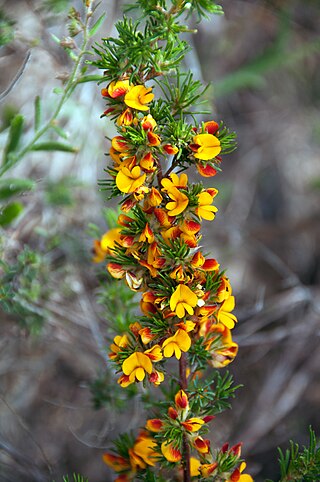
Pultenaea acerosa, commonly known as bristly bush-pea, is a species of flowering plant in the family Fabaceae and is endemic to south-eastern continental Australia. It is a rigid, much-branched shrub with glabrous, grooved, needle-shaped leaves and yellow flowers with red veins.
Pultenaea calycina is a species of flowering plant in the family Fabaceae and is endemic to near-coastal areas in the south of Western Australia. It is an erect, spindly shrub with flat or more or less cylindrical, grooved leaves and yellow and orange flowers.

Pultenaea canaliculata, commonly known as coast bush-pea, is a species of flowering plant in the family Fabaceae and is endemic to coastal areas of southern continental Australia. It is an rigid, spreading shrub with hairy, cylindrical leaves, and yellow and crimson flowers.
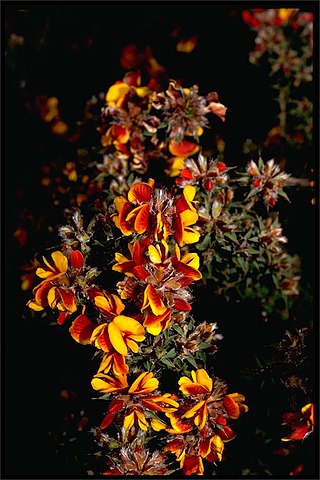
Pultenaea costata, commonly known as ribbed bush-pea, is a species of flowering plant in the family Fabaceae and is endemic to the Grampians National Park in Victoria. It is a spreading shrub with egg-shaped to lance-shaped leaves, and dense clusters of pea-like flowers.

Pultenaea divaricata is a species of flowering plant in the family Fabaceae and is endemic to a small area of New South Wales. It is an erect shrub with linear, needle-shaped, grooved leaves, and dense clusters of yellow to orange flowers with red markings.
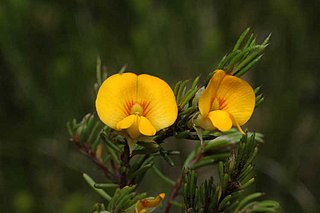
Pultenaea fasciculata, commonly known as alpine bush-pea or bundled bush-pea is a species of flowering plant in the family Fabaceae and is endemic to south-eastern Australia. It is a small prostrate or low-lying shrub with cylindrical leaves and yellow to orange-coloured flowers arranged singly or in small groups near the ends of branchlets.

Pultenaea graveolens, commonly known as scented bush-pea, is a species of flowering plant in the family Fabaceae and is endemic to Victoria, Australia. It is a strongly scented shrub with hairy stems, egg-shaped leaves with boat-shaped stipules at the base, and flowers that are mostly yellow.

Pultenaea laxiflora, commonly known as loose-flower bush-pea, is a species of flowering plant in the family Fabaceae and is endemic to south-eastern continental Australia. It is a low-lying to prostrate, spreading shrub with linear to narrow egg-shaped leaves with the narrower end towards the base, and yellow and red to brown or purple flowers.

Pultenaea luehmannii, commonly known as thready bush-pea, is a species of flowering plant in the family Fabaceae and is endemic to the Grampians National Park. It is a diffuse, more or less prostrate sub-shrub with trailing branches, narrow elliptic leaves, and orange and dark brown flowers.
Pultenaea maidenii, commonly known as Maiden's bush-pea, is an extinct species of flowering plant in the family Fabaceae and was endemic to Victoria, Australia. It was an erect shrub with egg-shaped leaves with the narrower end towards the base, and pea-shaped flowers.
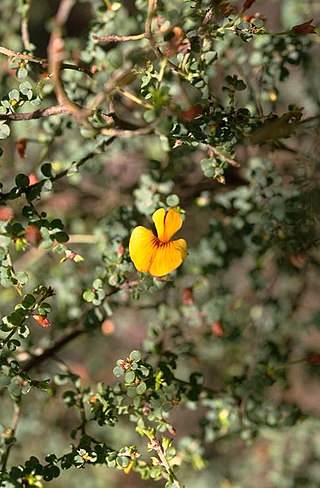
Pultenaea patellifolia, commonly known as Mt Byron bush-pea, is a species of flowering plant in the family Fabaceae and is endemic to the Black Range in the Grampians National Park in Victoria. It is a spreading shrub with round leaves, and clusters of yellow and red, pea-like flowers.

Pultenaea platyphylla, commonly known as flat-leaf bush-pea, is a species of flowering plant in the family Fabaceae and is endemic to south-eastern continental Australia. It is an erect, rigidly-branched shrub with narrow egg-shaped to wedge-shaped leaves with the narrower end towards the base, and yellow to orange and red to purple flowers.
Pultenaea prolifera, commonly known as Otway bush-pea, is a species of flowering plant in the family Fabaceae and is endemic to the south coast of Victoria. It is an erect shrub with needle-shaped leaves, and yellow and red pea-like flowers arranged singly in leaf axils on the ends of short side branches.
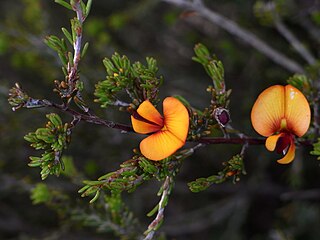
Pultenaea prostrata, commonly known as silky bush-pea, is a species of flowering plant in the family Fabaceae and is endemic to south-eastern Australia. It is a small, rigid, wiry, low-lying or prostrate shrub with cylindrical leaves, and yellow, red and purple-brown flowers.
Pultenaea radiata is a species of flowering plant in the family Fabaceae and is endemic to the south-west of Western Australia. It is an erect, open shrub with linear, needle-shaped, grooved leaves, and clusters of red and pinkish-purple flowers.
Pultenaea robusta is a species of flowering plant in the family Fabaceae and is endemic to eastern Australia. It is an erect shrub with hairy branches, linear leaves, and yellow to orange and red to purple, pea-like flowers.
Pultenaea trichophylla, commonly known as tufted bush-pea, is a species of flowering plant in the family Fabaceae and is endemic to South Australia. It is a slender, prostrate to erect shrub with hairy branchlets, lance-shaped leaves, and yellow to orange and red, pea-like flowers.

Pultenaea viscidula, commonly known as dark bush-pea, is a species of flowering plant in the family Fabaceae and is endemic to South Australia. It is an erect shrub with branches that are sticky when young, linear to cylindrical, channelled leaves with stipules at the base, and yellow to orange and yellow-red to green flowers.

Pultenaea williamsoniana, commonly known as Williamson's bush-pea, is a species of flowering plant in the family Fabaceae and is endemic to a restricted area of Victoria, Australia. It is a slender, erect shrub with its stems covered with white hairs, and has cylindrical, grooved leaves and yellow to orange and red, pea-like flowers arranged in clusters on the ends of short side branches.














